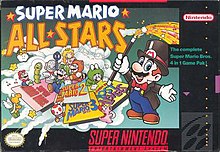| Super Mario All-Stars | |
|---|---|
 | |
| Developer(s) | Nintendo EAD |
| Publisher(s) | Nintendo |
| Director(s) | Takashi Tezuka |
| Producer(s) | Shigeru Miyamoto |
| Programmer(s) | Toshihiko Nakago |
| Artist(s) |
|
| Composer(s) |
|
| Series | Super Mario |
| Platform(s) | Super NES, Wii |
| Release | Super NESWii |
| Genre(s) | Platform |
| Mode(s) | Single-player, multiplayer |
Super Mario All-Stars[a] is a 1993 compilation of platform games for the Super Nintendo Entertainment System (SNES). It contains remakes of Nintendo's four Super Mario games released for the Nintendo Entertainment System (NES) and the Famicom Disk System: Super Mario Bros. (1985), Super Mario Bros.: The Lost Levels (1986), Super Mario Bros. 2 (1988), and Super Mario Bros. 3 (1988). As in the original games, players control the Italian plumber Mario and his brother Luigi through themed worlds, collecting power-ups, avoiding obstacles, and finding secrets. The remakes feature updated graphics—including the addition of parallax scrolling—and music, modified game physics, a save feature, and bug fixes.
Nintendo Entertainment Analysis & Development developed the compilation after completing Super Mario Kart (1992), at the suggestion of the Mario creator, Shigeru Miyamoto. No longer restricted by the limitations of the 8-bit NES, Nintendo remade them for the 16-bit SNES. The developers based the updated designs on those from Super Mario World (1990) and strove to retain the feel of the original games. Nintendo released Super Mario All-Stars worldwide in late 1993 and rereleased it in 1994 with Super Mario World included. It was The Lost Levels' first release outside Japan; it was not released on the NES in Western territories because Nintendo deemed it too difficult at the time.
Super Mario All-Stars is one of the bestselling Super Mario games, with 10.55 million copies sold by 2015. Critics considered it one of the best SNES games and praised the updated graphics and music, but criticized its lack of innovation. All-Stars served as a basis for later Super Mario rereleases and was described by Famitsu as a model for video game remakes. It was rereleased twice for the anniversary of Super Mario Bros.: in 2010 (the 25th anniversary) in a special package for the Wii, and in 2020 (the 35th anniversary) for the Nintendo Switch as part of the Nintendo Switch Online legacy games service. The Wii rerelease sold 2.24 million copies by 2011 but received mixed reviews, with criticism for its lack of new games and features.
- ^ "業務実績" [Business Performance]. DJ Alice (in Japanese). January 3, 2007. Archived from the original on September 30, 2012.
Cite error: There are <ref group=lower-alpha> tags or {{efn}} templates on this page, but the references will not show without a {{reflist|group=lower-alpha}} template or {{notelist}} template (see the help page).